An Experimental Analysis of Water–Air Two-Phase Flow Pattern and Air Entrainment Rate in Self-Entrainment Venturi Nozzles
Abstract
:1. Introduction
2. Experimental Method
3. Results and Discussion
3.1. Visualization of Water–Air Two-Phase Flows
3.2. Effect of the Two-Phase Flow Pattern on Air Entrainment Characteristics
3.3. Pressure Drops According to the Two-Phase Flow Pattern
4. Conclusions
Author Contributions
Funding
Institutional Review Board Statement
Informed Consent Statement
Data Availability Statement
Conflicts of Interest
References
- Baylar, A.; Ozkan, F. Applications of venturi principle to water aeration systems. Environ. Fluid Mech. 2006, 6, 341–357. [Google Scholar] [CrossRef]
- Temesgena, T.; Bui, T.T.; Han, M.Y.; Kim, T.I.; Park, H.J. Micro and nanobubble technologies as a new horizon for water-treatment techniques: A review. Adv. Colloid Interface Sci. 2017, 246, 40–51. [Google Scholar] [CrossRef]
- Thalasso, F.; Naveau, H.; Nyns, E.H. Design and performance of a bioreactor equipped with a venturi injector for high gas transfer rates. Chem. Eng. J. Biochem. Eng. J. 1995, 57, B1–B5. [Google Scholar] [CrossRef]
- Pak, S.L.; Chang, K.S. Performance estimation of a venturi scrubber using a computational model for capturing dust particles with liquid spray. J. Hazard. Mater. 2006, 138, 560–573. [Google Scholar] [CrossRef]
- Zhao, L.; Sun, L.; Mo, Z.; Tang, J.; Hu, L.; Bao, J. An investigation on bubble motion in liquid flowing through a rectangular venturi channel. Exp. Therm. Fluid Sci. 2018, 97, 48–58. [Google Scholar] [CrossRef]
- Gordiychuk, A.; Svanera, M.; Benini, S.; Poesio, P. Size distribution and sauter mean diameter of micro bubbles for a venturi type bubble generator. Exp. Therm. Fluid Sci. 2016, 70, 51–60. [Google Scholar] [CrossRef]
- Huang, J.; Sun, L.; Du, M.; Mo, Z.; Zhao, L. A visualized study of interfacial behavior of air-water two-phase flow in a rectangular venturi channel. Theor. Appl. Mech. Lett. 2018, 8, 334–344. [Google Scholar] [CrossRef]
- Reichmann, F.; Tollkötter, A.; Körner, S.; Kockmann, N. Gas-liquid dispersion in micronozzles and microreactor design for high interfacial area. Chem. Eng. Sci. 2017, 169, 151–163. [Google Scholar] [CrossRef]
- Lee, C.H.; Choi, H.; Jerng, D.W.; Kim, D.E.; Wongwises, S.; Ahn, H.S. Experimental investigation of microbubble generation in the venturi nozzle. Int. J. Heat Mass Transf. 2019, 136, 117–138. [Google Scholar] [CrossRef]
- Emiroglu, M.E.; Baylar, A. Study of the influence of air holes along length of convergent-divergent passage of a venturi device on aeration. J. Hydraul. Res. 2003, 41, 513–520. [Google Scholar] [CrossRef]
- Kim, D.J.; Park, S.K.; Yang, H.C. Mixed flow and oxygen transfer characteristics of vertical orifice ejector. Trans. Korean Soc. Mech. Eng. B 2015, 39, 61–69. [Google Scholar] [CrossRef] [Green Version]
- Guerra, V.G.; Béttega, R.; Gonçalves, J.A.S.; Coury, J.R. Pressure drop and liquid distribution in a venturi scrubber: Experimental data and CFD simulation. Ind. Eng. Chem. Res. 2012, 51, 8049–8060. [Google Scholar] [CrossRef]
- Baylar, A.; Aydin, M.C.; Unsal, M.; Ozkan, F. Numerical modeling of venturi flows for determining air injection rates using Fluent V6. 2. Math. Comput. Appl. 2009, 14, 97–108. [Google Scholar]
- Roul, M.K.; Dash, S.K. Two-phase pressure drop caused by sudden flow area contraction/expansion in small circular pipes. Int. J. Numer. Methods Fluids 2011, 66, 1420–1446. [Google Scholar] [CrossRef]
- Hwang, J.J.; Tseng, F.G.; Pan, C. Ethanol-CO2 two-phase flow in diverging and converging microchannels. Int. J. Multiph. Flow 2005, 31, 548–570. [Google Scholar] [CrossRef]
- Lee, P.C.; Pan, C. Boiling heat transfer and two-phase flow of water in a single shallow microchannel with a uniform or diverging cross section. J. Micromech. Microeng. 2008, 18, 025005. [Google Scholar] [CrossRef]
- Kishore, B.N.; Jayanti, S. A multidimensional model for annular gas–liquid flow. Chem. Eng. Sci. 2004, 59, 3577–3589. [Google Scholar] [CrossRef]
- Lockhart, R.W.; Martinelli, R.C. Proposed correlation of data for isothermal two-phase, two-component flow in pipes. Chem. Eng. Prog. 1949, 45, 39–48. [Google Scholar]
- Muzychka, Y.S.; Awad, M.M. Asymptotic generalizations of the Lockhart-Martinelli method for two phase flows. J. Fluids Eng. 2010, 132, 031302. [Google Scholar] [CrossRef]
- Chisholm, D. A theoretical basis for the Lockhart-Martinelli correlation for two phase flow. Int. J. Heat Mass Transf. 1967, 10, 1767–1778. [Google Scholar] [CrossRef]
- Mishima, K.; Hibiki, T. Some characteristics of air-water two phase flow in small diameter vertical tubes. Int. J. Multiph. Flow 1996, 22, 703–712. [Google Scholar] [CrossRef]
- Yang, Z.; Dang, Z.; Yang, X.; Ishii, M.; Shan, J. Downward two phase flow experiment and general flow regime transition criteria for various pipe sizes. Int. J. Heat Mass Transf. 2018, 125, 179–189. [Google Scholar] [CrossRef]
- Taitel, Y.; Barnea, D.; Dukler, A.E. Modeling flow pattern transition for gas–liquid transitions for steady upward gas–liquid flow in vertical tubes. AIChE J. 1980, 26, 345–354. [Google Scholar] [CrossRef]
- Barnea, D.; Luninski, Y.; Taitel, Y. Flow pattern in horizontal and vertical two phase flow in small diameter pipes. Can. J. Chem. Eng. 1983, 61, 617–620. [Google Scholar] [CrossRef]
- Barnea, D.; Shoham, O.; Taitel, Y. Flow pattern transition for vertical downward two phase flow. Chem. Eng. Sci. 1982, 37, 741–746. [Google Scholar] [CrossRef]

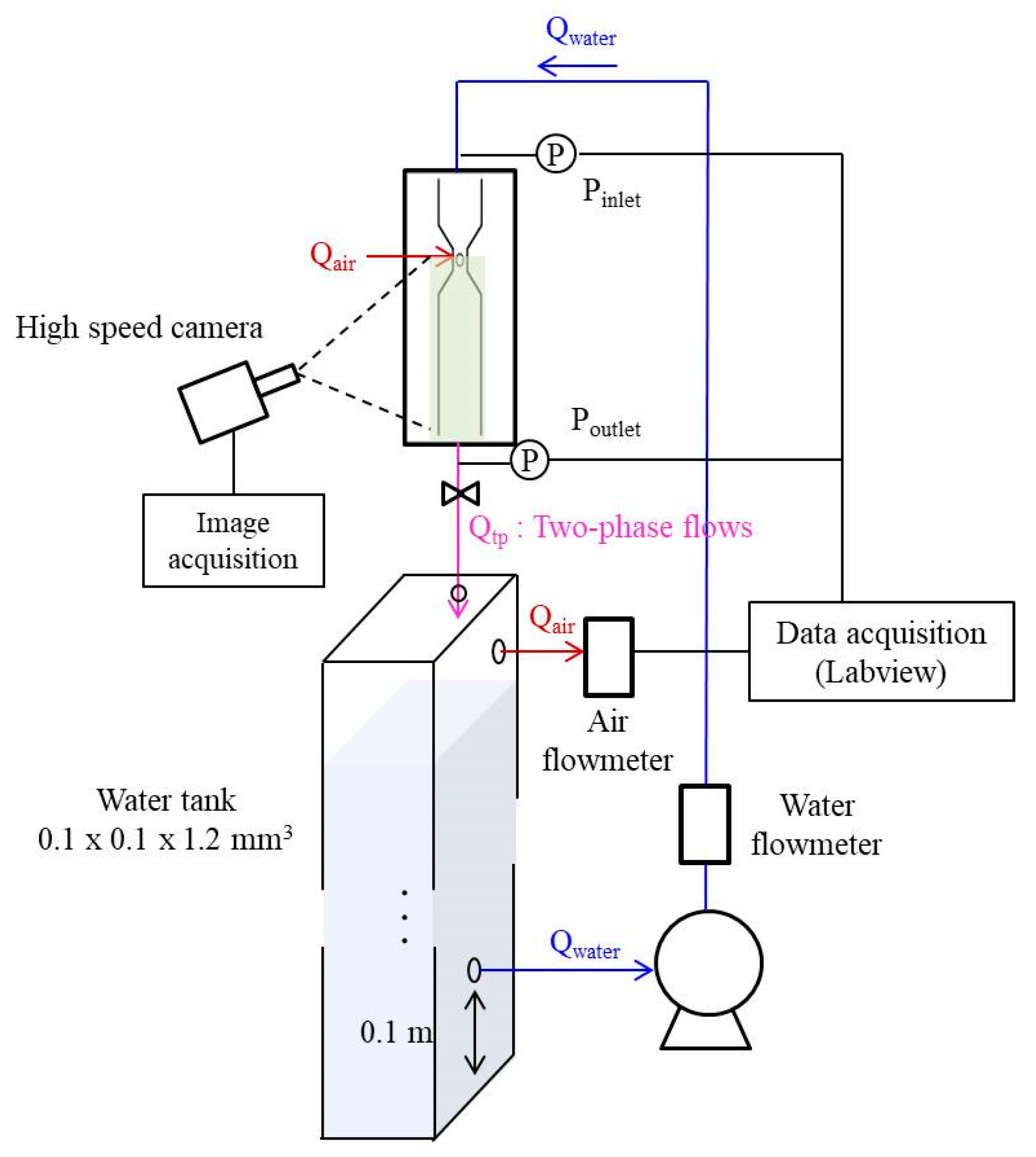



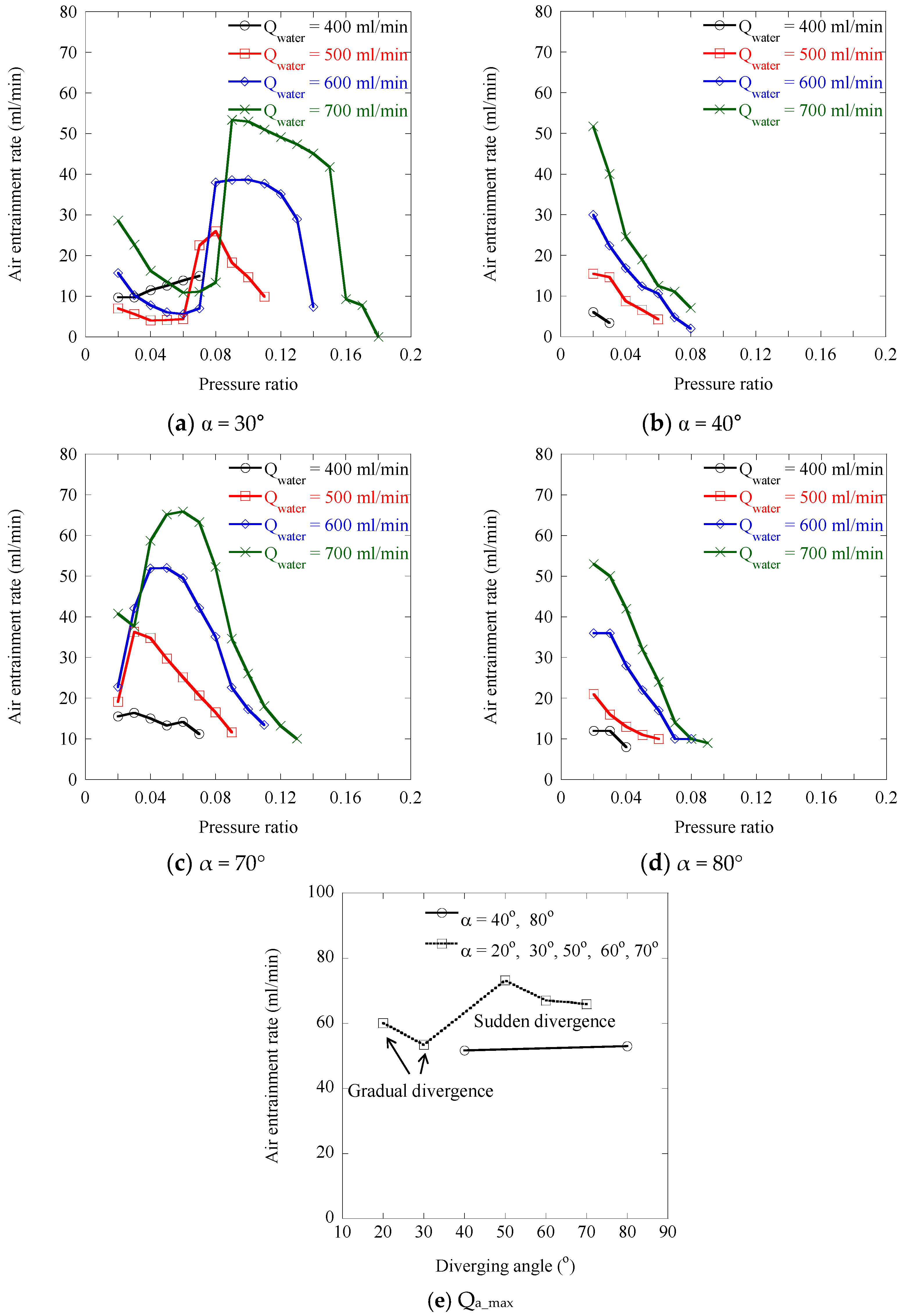
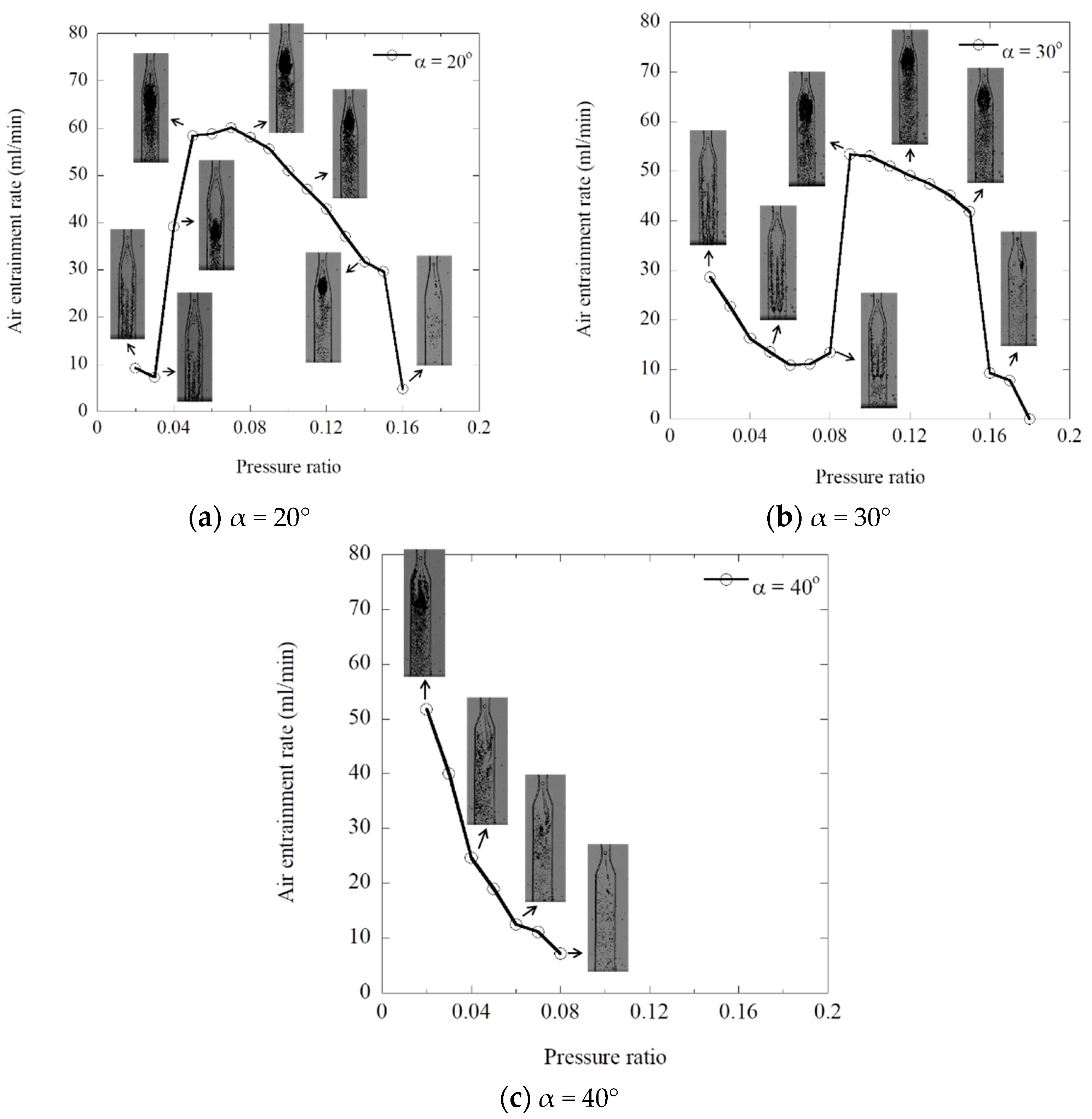
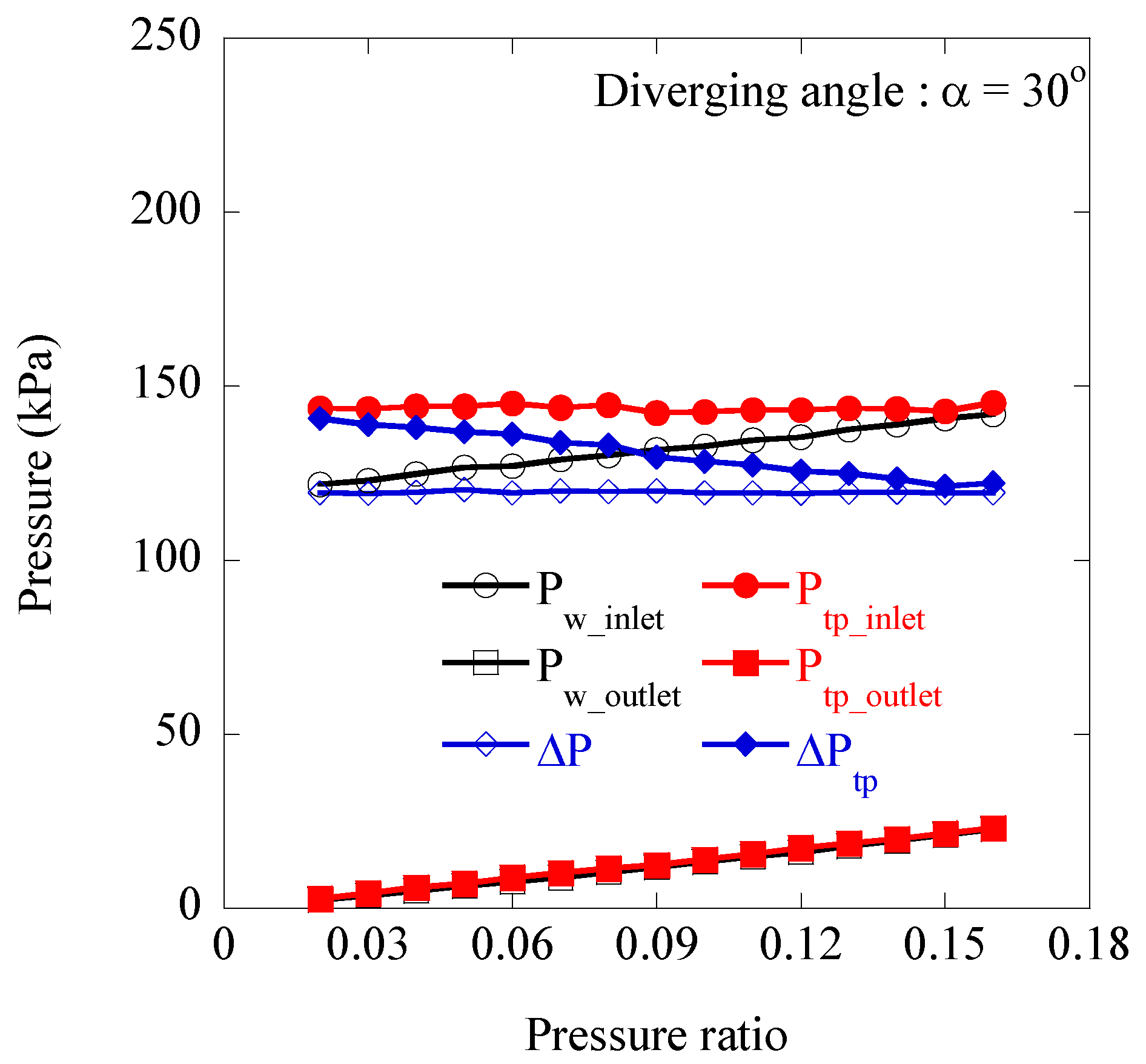
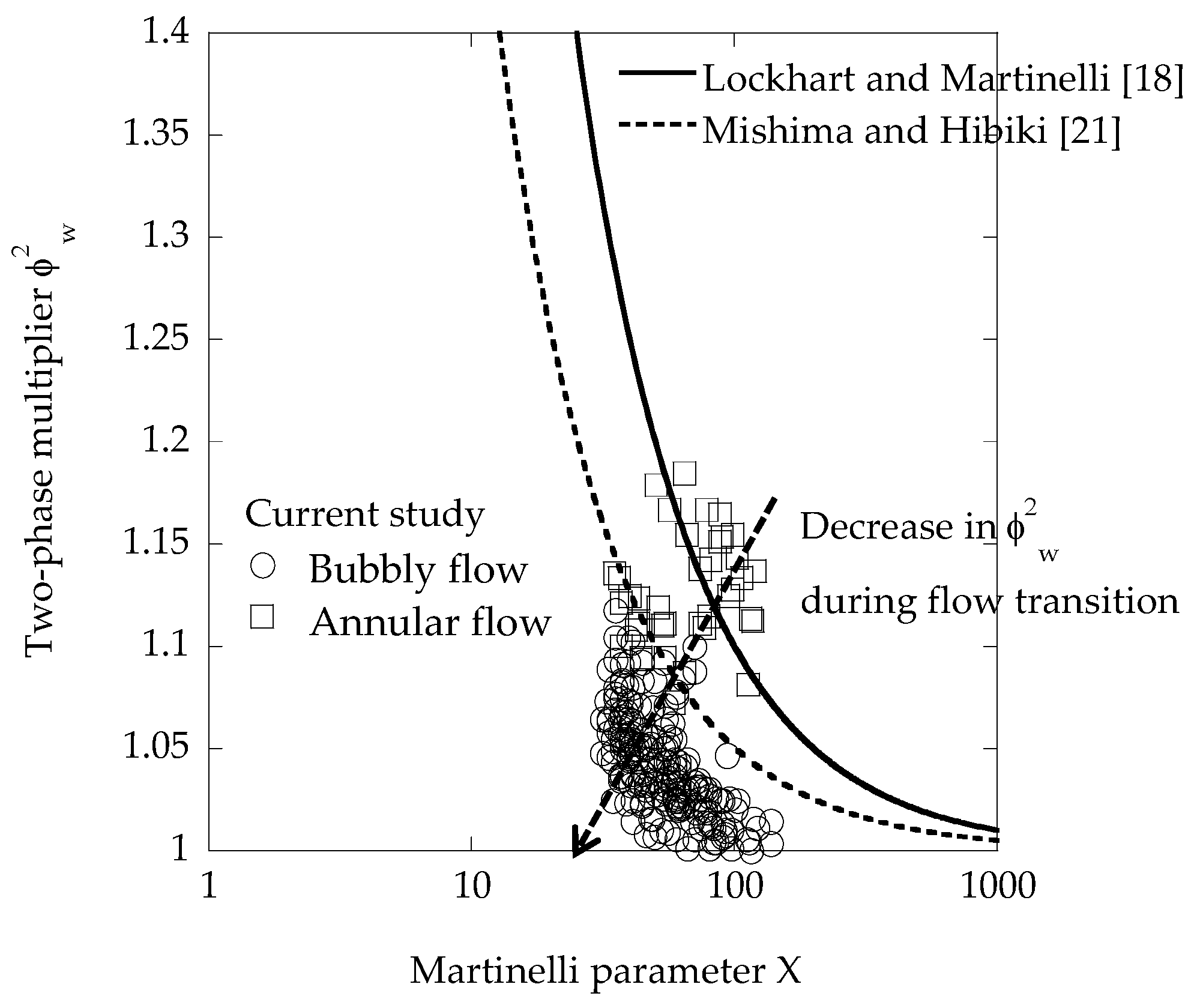
| α | Qwater (mL/min) | Pr_max | α | Qwater (mL/min) | Pr_max |
|---|---|---|---|---|---|
| 20° | 400 | 0.09 | 60° | 400 | 0.04 |
| 500 | 0.12 | 500 | 0.08 | ||
| 600 | 0.15 | 600 | 0.10 | ||
| 700 | 0.16 | 700 | 0.11 | ||
| 30° | 400 | 0.07 | 70° | 400 | 0.07 |
| 500 | 0.11 | 500 | 0.09 | ||
| 600 | 0.14 | 600 | 0.11 | ||
| 700 | 0.18 | 700 | 0.13 | ||
| 40° | 400 | 0.03 | 80° | 400 | 0.04 |
| 500 | 0.06 | 500 | 0.06 | ||
| 600 | 0.08 | 600 | 0.08 | ||
| 700 | 0.08 | 700 | 0.09 | ||
| 50° | 400 | 0.11 | |||
| 500 | 0.12 | ||||
| 600 | 0.14 | ||||
| 700 | 0.15 |
| Measurement Device | Full Scale | Accuracy | |
|---|---|---|---|
| Water flowmeter | ~5 L/min | 2% R.S. | |
| Air flowmeter | ~200 mL/min | 1% F.S. | |
| Pressure sensor | Inlet | 0~1 MPa | 1 kPa |
| Outlet | −101 kPa~101 kPa | 0.1 kPa | |
Publisher’s Note: MDPI stays neutral with regard to jurisdictional claims in published maps and institutional affiliations. |
© 2021 by the authors. Licensee MDPI, Basel, Switzerland. This article is an open access article distributed under the terms and conditions of the Creative Commons Attribution (CC BY) license (https://creativecommons.org/licenses/by/4.0/).
Share and Cite
Bae, H.; Sung, J. An Experimental Analysis of Water–Air Two-Phase Flow Pattern and Air Entrainment Rate in Self-Entrainment Venturi Nozzles. Energies 2021, 14, 2664. https://doi.org/10.3390/en14092664
Bae H, Sung J. An Experimental Analysis of Water–Air Two-Phase Flow Pattern and Air Entrainment Rate in Self-Entrainment Venturi Nozzles. Energies. 2021; 14(9):2664. https://doi.org/10.3390/en14092664
Chicago/Turabian StyleBae, Hyunwoo, and Jaeyong Sung. 2021. "An Experimental Analysis of Water–Air Two-Phase Flow Pattern and Air Entrainment Rate in Self-Entrainment Venturi Nozzles" Energies 14, no. 9: 2664. https://doi.org/10.3390/en14092664
APA StyleBae, H., & Sung, J. (2021). An Experimental Analysis of Water–Air Two-Phase Flow Pattern and Air Entrainment Rate in Self-Entrainment Venturi Nozzles. Energies, 14(9), 2664. https://doi.org/10.3390/en14092664





